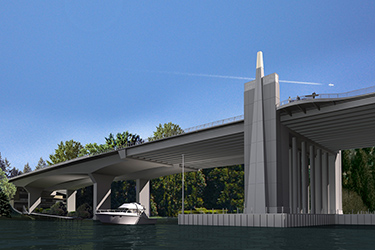|
Subscribe / Renew |
|
|
Contact Us |
|
| ► Subscribe to our Free Weekly Newsletter | |
| home | Welcome, sign in or click here to subscribe. | login |
Construction
| |
 |
April 14, 2016
How ‘belvederes’ and ‘sentinels’ helped make the bridge look the way it does
Helix Design Group

McKean
|
The overarching design themes for the entire state Route 520 corridor are land, air and water.
For the Floating Bridge and Landings Project, these themes find their expression as we trace the passage from the “land” at the west- and east-side approaches, “air” as the route transitions from high-rise to the low-rise floating bridge, and “water” as the bridge descends to the floating bridge component closest to the lake.
The intent of the bridge design is to harmonize with other corridor projects to create a unified corridor aesthetic along the path between Interstate 5 in Seattle and Interstate 405 in Bellevue.
As the focus of the corridor path, the bridge design must respond to many factors, including bridge users such as motorists, pedestrians, bicyclists and boaters, as well as the adjacent neighborhood and viewers outside of the corridor.
Helix Design Group was a member of Kiewit-General-Manson’s design-build team and the architectural design consultant to KPFF Consulting Engineers for all aesthetic design aspects of the bridge.
Gateways to the bridge
The bridge can be seen as a series of thin, horizontal bands signifying the water that is punctuated by the strong vertical elements of the sentinel as well as elements that mark the significant transition points, provide scale and create a rhythmic meter for travelers.
The sentinel elements are designed to respond to a variety of influences in the bridge design. The sentinels must reflect the overall horizontal scale of the bridge from a regional perspective, while also respecting the scale of the pedestrians and motorists on the bridge.
The sentinels form the “gateway” to and from the floating bridge and mark the termination of the floating portion and transition to the land structures. The shape and form of the sentinel element is an expression that captures the energy of the horizontal water and links it to the sky — the source of water — through a thin, lighted pylon celebrating the nature of the floating bridge.
The low-rise structure on the floating bridge was designed to emphasize the transparency and lightness of the water. However, because of the loads imposed by the transition span linking the bridge to the shore, the superstructure of the bridge at this location is very massive. The vertical emphasis of the sentinel then is designed to mask this heavy mass to help maintain the sense of lightness and transparency.
Illumination transforms the sentinel elements in the evening darkness with a projected band of light extending from the water to the sky through the beacons which terminate at the top. A continuous green wash of light complements the amber beacon and light band while defining the vertical pylon.
A series of 10-foot-tall “spikes” that line the bridge — 20 on each side — mark the pontoon joints and provide an additional level of measure for travelers. Lighting is an integral component of these elements, making a relationship to the sentinel beacons and continuing the rhythmic markers into the evening darkness.
Pedestrian spaces
The regional pedestrian/bike path allows travelers to experience the bridge from a slower and more intimate perspective than motorists. This allows close viewing of bridge details and a more relaxed view of regional landscape and distant features.
Development of the design included participation of community members, the Seattle Design Commission, the Washington State Department of Transportation and others to ensure that the layout and details were consistent with the stature of the bridge as well as continuation of the pathway to the east and west of the bridge.
The pathway includes “belvederes,” or overlook platforms, spaced at logical intervals along the entire bridge length, which allow places to rest and view the bridge and surrounding natural environment. Design elements included a continuous bridge railing that blends horizontal and vertical elements, maintains transparency to the water as well as a guardrail for pedestrians and cyclists.
The belvederes include a concrete, metal and glass windscreen to protect pedestrians seated at the bench from the wind and noise of the adjacent freeway. Each belvedere includes specialty lighting used to accent the elements while also providing security.
Bruce McKean is Helix Design Group’s founding principal, with over 30 years of experience as an architect. He was the principal architect for all aesthetic design aspects of the floating bridge project.
Other Stories:
- Building the bridge was an intricate undertaking
- How much do you know about the new 520 bridge?
- WSDOT ‘nerve center’ keeps watch over the bridge
- The floating bridge opening has been a long time coming



